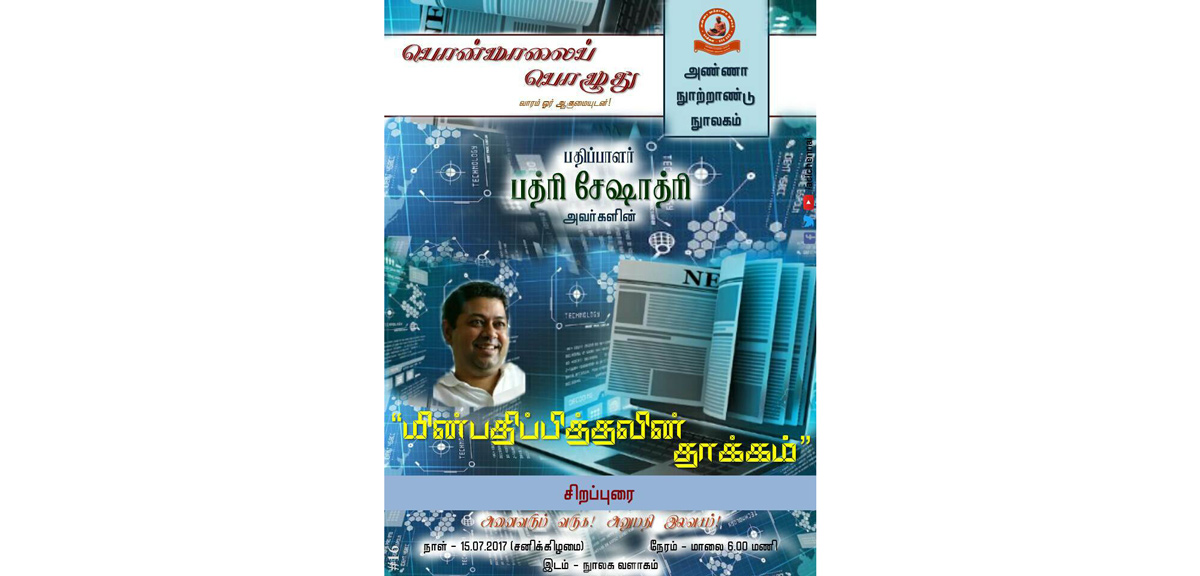Anna Centenary Library in Kotturpuram, Chennai is a world-class facility established in 2010 (my first visit), due to prevailing politics its maintenance has seen ups and downs, but still, it’s a wonderful place for book-lovers. Recently the Library department has been organising here in the spacious meeting hall (my talk on NLP last here was given here) weekly talks by experts on various subjects. As part of that programme titled “பொன்மாலைப்பொழுது”, my good friend Badri Seshadri delivered a talk today on “Impact of E-Books” (“மின்பதிப்பித்தலின் தாக்கம்”). Being a voracious reader, blogger, a publisher of repute, and a technologist, Badri had a tonne of experience to share about his journey of publishing e-books. Video of his talk delivered in Tamil is available here, so I will share only a few highlights of what I understood from his presentation:
Before going into e-books, first, we need to look at the process of publication of books as it is followed in India. The stakeholders can be listed as:
- Writer
- Publisher
- Printer
- Distributors
- Bookstore
- Library
- Researchers
- Reader
Without the writer, no book can be born. An ideal publisher should be the one who identifies/nurtures a writer, invests money, polishes the work by employing qualified editors, designs the book, market the work, distributes the book and pays out the royalty to the writer. A printer produces the paper books after printing, binding and packaging. Distributors and Bookstores procure, stock and sell the books. A library makes available of many genres, costs sourcing it from around the world. Finally, Researchers and Readers are the consumers of the works.
With ebooks, the above setup is being disrupted. While Writers and Readers are going to be always there, their roles safe and probably growing with ebooks, the same can’t be said of the other layers. The role played by those in middle from a Publisher to a Library is being torn-apart. Printers especially traditional offset style printers/binders have started having the most pain when books are not printed on paper, their role will be eliminated fast. When printers go away, with them they take down Distributors and corner Bookstores as well – we have been already seeing them in our neighbourhoods and cities.
Writers can self-publish through platforms like Amazon KDP or Google Books, bypassing everyone else between them and their readers. While a good publisher as we have seen earlier does a whole lot of value addition, they are not a must anymore, but still useful and necessary most often.
With ebooks the biggest beneficiary undoubtedly are the Readers, they didn’t have it better like now anytime in the past. They can purchase ebooks at prices far cheaper than paper books, buy them from anywhere in the world with a press of a button and credit card, eliminate the problems of storing and safeguarding them from fire/water/ageing. Searching a book and searching within a book becomes instantaneous making access to knowledge convenient. On top of this, books which are out of copyright (in India that is 60 years from the date of death of the original writer) are available for free as ebooks from – Amazon Kindle Free, Project Gutenberg, Project Madurai, Free Tamil Books and others.
Reading any ebook is made super easy with apps like Kindle available on every smartphone platform. If you are worried of the eye-strain from staring at LCD/LED screens you have the technological wonder called e-ink available from dedicated reading devices like Amazon Kindle which starts from Rs.4999, with prices falling rapidly – though this may sound high, if you think about the number of books it gives you access to, it starts becoming affordable.



